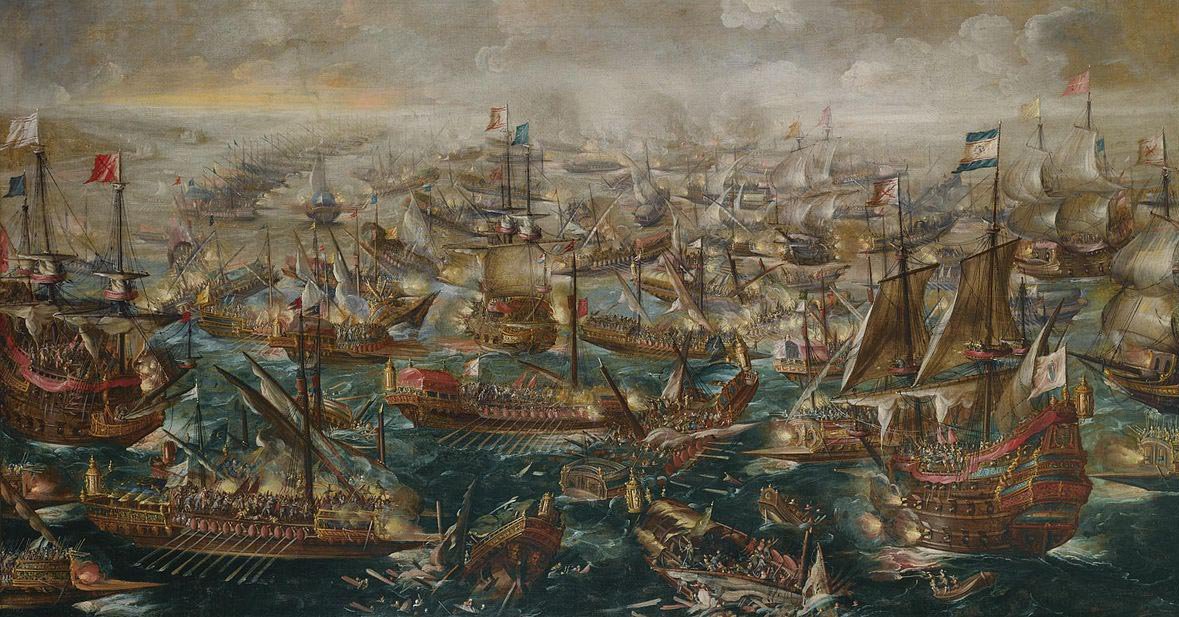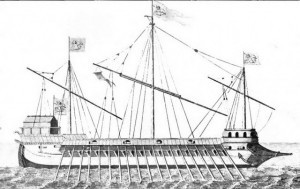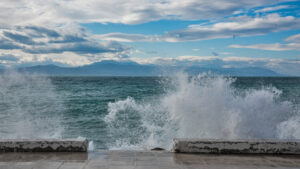The Ottoman Empire grew from being a minor power in modern Turkey to controlling much of the Middle East and Eastern Europe. By 1453, they had broken the power of the Byzantine Empire and taken the great city of Constantinople as their new capital of Istanbul. Constantinople had been the biggest thorn in the side of westward expansion and after it was taken the powerful Ottomans burst into Eastern Europe and quickly challenged Venice for control of the seas.
Due to their vast resources, the Ottomans quickly got the upper hand in the Mediterranean and had control of most of the islands east of Greece by 1570 and were able to secure most of Northern Africa including areas around modern day Tunis. With their power the Ottomans freely conducted raids along the Christian kingdoms of Italy, Spain, and Malta, destroying towns and taking thousands of slaves.
Finally, Pope Pius V had enough and made great efforts to gather a Holy League to combat the encroaching Ottoman threat. This was easier said than done as Western Europe was full of fractious states almost always embroiled in conflict. The Ottoman raids hit many of the coastal powers, however, and helped motivate the union that was formed between the Venetians, who had been fighting a losing naval war against the Ottomans for over a century, the Knights of Malta, The Spanish Empire, and several smaller Italian powers.
The force assembled numbered around 200 galleys, the standard ship of the day. A galley was not much different than ancient triremes, long and narrow, and tactics still involved ramming or boarding ships. With the growth of gunpowder, many ships had cannons on the front, which did little to change tactics still geared towards a frontal assault or boarding.
One new invention present were six Galleasses, larger and wider ships that had small wooden castles built into their decks that housed a large assortment of cannons able to fire in all directions. The downside was that these ships were so wide and heavy that they needed to be towed into position and maneuvered terribly slowly.
Depiction of one of the Galleasses at Lepanto
The Ottomans had around 240 galleys though they relied less on cannons and more on well-trained composite bowmen in their navy. In addition, the Ottomans had as many as 100 smaller vessels intended for flanking and harassing moves.
The navy of the Holy League initially set out to rescue the eastern island of Cyprus, stoutly resisting the Ottomans at their doorstep for years. By the time they set sail, however, the island had fallen and the commander of the last fortress tortured and murdered. Now sailing for revenge, the Holy League headed towards the above-mentioned Ottoman fleet that was near Lepanto in the Gulf of Corinth. Early in the morning on October 7th, 1571 the two fleets would meet for the largest naval battle of the Renaissance era.
With the Holy League entering the gulf from the west their left, northern flank was just off the coast, their center separated to the south and the right southern flank angled outward to prevent flanking. The six large galleasses were divided into pairs for each section. The north and center sections had theirs out in front of the lines, but the southern pair were unable to get in position before the Ottomans closed.
What is odd about the battle is that both sides thought they had the numerical advantage, and both were goaded into battle, the Holy League by the Pope and the Ottomans by Sultan Selim II, who sought a glorious victory. The Holy League commander, John of Austria, was chosen due to his ability to placate all the factions in the Navy and kept the collective focus on defeating the Ottomans.
The Ottoman commander Ali Pasha was a skilled commander, but had not seen anything like the new galleasses nor had he fought in a battle nearly this large. Pasha’s ship was adorned with the “Banner of the Caliphs”, a large green embroidered banner with texts from the Quran intended to inspire the men similar to the Roman Eagle or the relic of the true cross.
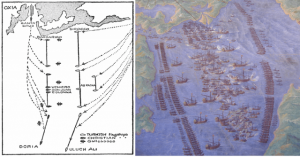
Drawing and painting of the approximate troop positions just prior to the main battle
The battle was actually more like three separate battles as the northern, center and southern sections fought largely independently. In the northern and center sections, the four Galleasses proved to be insurmountable obstacles as they were too fortified to take so the Ottomans simply passed them and the Galleasses unleashed fire from all sides to serious disorganize the Ottoman lines of attack. In the far North, the Ottomans used their lighter and smaller ships to hug the shallow coastlines in a wide flanking attempt.
The northern flank commander, Barbarigo saw this and sent his own ship to hold off a flank. Barbarigo died in the attempt, but his northern section was able to rotate their whole force and began to drive the Ottomans straight into the shallow coast. One of the galleasses was able to lumber back, and its superior firepower helped to essentially win the northern section for the Holy League.
The center saw the fiercest fighting as though the Ottomans were disorganized from passing the galleasses, they had more ships and outmaneuvered the Holy League with their lighter ships. Ships smashed into each other and formed continuous platforms turning the naval battle into isolated field combat with mixes of cannons, guns and bows.

The battle quickly turned into a churning mess of ships, especially in the center.
Several ships from the Holy League saw the large green banner from Ali Pasha’s ship and correctly targeted as a ship of great importance. Pasha’s men fought bravely against several ships but ultimately Pasha was killed, and his ship captured.
At this point, it was remarked that many Holy League ships resembled porcupines due to the amount of arrows in them, and slowly the Ottoman ships were captured or sunk in the hardest fighting of the battle. the elite Ottoman Janissaries fought the hardest and refused to surrender even as Pasha’s death prompted many around them to surrender.
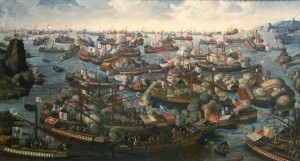
Combatants remarked that Lepanto was awe inspiring due to its size even as it was going on around them.
It was said that as the Janissaries ran out of ammunition, they began throwing whatever they could find at those boarding their ships. The Galleasses had done enough at the outset, and their presence behind the lines prevented organized retreat or regrouping.
The southern section had more maneuvering than fighting. Seeking to flank, the Ottomans traveled further south but were matched by the Holy League. As the Holy League moved farther south, a gap between them and their center opened, and the Ottomans reversed direction and drove into the gap and attacked the newly exposed flank as well as the southern portion of the center section. They had great success and threatened to rout the southern section until they realized that the battle was all but lost. Those who could, went through the gap and fled through the rear of the Holy League lines.
The victor of naval battles got a bonus in captured ships and the Holy League certainly came out on top, capturing 137 ships. As an added bonus many of the rowers for the Ottomans were captured Christian slaves, now freed. The Ottomans lost as many as 20,000 sailors and skilled bowmen compared to around 7,000 men and 17 ships for the Holy League.
The Ottomans did hold on to Cyprus but their naval supremacy in the Mediterranean, where they had not lost a major engagement in a century, was shattered. For the first time since the fall of Constantinople, the Ottomans were firmly and spectacularly defeated. Their power was too strong for any counter attacks, but Ottoman raids and naval expansion was halted for the time. On land, it would take several more decades for the Ottoman wave to be halted.
By William McLaughlin for War History Online
Ask me anything
Explore related questions
